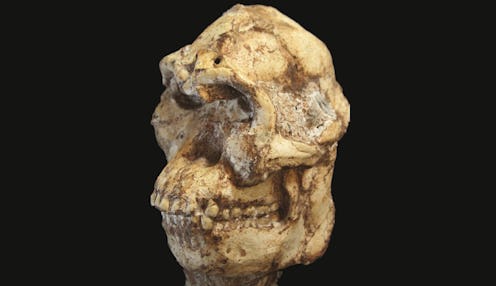News
"Little Foot" Skull Is 3.67 Million Years Old

When scientists first unearthed a remarkably preserved Australopithecus skeleton in a South African cave system in 1994, they likely had no idea that it would be one of the greatest archaeological discoveries in recent times. At the time of its historic unveiling in 1998, the specimen, dubbed "Little Foot", was considered to be one of the most complete early hominid skeletons ever discovered — and thanks to new radioisotopic technology, it's now considered to be one of the oldest as well. On Wednesday, a team of researchers from Purdue University in Indiana, the University of the Witwatersrand in South Africa, the University of New Brunswick in Canada, and the University of Toulouse in France released a statement in the journal Nature, indicating that the hominid was much older than previously assumed — Little Foot was, in fact, around 3.67 million years old, making it the earliest known human relative to date.
Australopithecus, an early ancestor to modern day humans, has made the headlines before: in 1974, archaeologists unearthed the now-famous "Lucy" in the Awash Valley in Ethiopia, dating the specimen back nearly 3.2 million years. Long thought to be one of the oldest human relatives ever discovered in the fossil record, Lucy's reign ended on April 1 as the Little Foot research team made its exciting announcement.
"We have only a small number of sites and we tend to base our evolutionary scenarios on the few fossils we have from those sites," said Ronald Clarke, research co-author and professor of Evolutionary Studies at the University of the Witwatersrand, who first discovered the bones. "This new date is a reminder that there could well have been many species of Australopithecus extending over a much wider area of Africa."
The new radioisotopic technology relies on a decoding system that analyzes the minerals surrounding a fossil or skeleton in order to determine from the local age of the specimen. By breaking down the radioactive isotopes aluminum-26 and beryllium-10 in the surrounding quartz, the technology is able to pinpoint an accurate date of burial to around ± 0.16 million years.
Aluminum-26 and beryllium-10 are only created when "rock is exposed to cosmic rays", explained co-author Darryl Granger, a professor of earth, atmospheric and planetary sciences at Purdue, in a statement. After rock is buried, the isotopes begin to decay over time, leaving behind a timeline of its ancient past, in a sense.
"The original [age of Little Foot] we published was considered to be too old, and it wasn't well received," he said. "However, dating the Little Foot fossil as 3.67 million years old actually falls within the margin of error we had for our original work — it turns out it was a good idea after all."
The discovery was something of a relief for Granger and his colleagues, whose previous work had been waved off as inaccurate.
"We had given up and nearly walked away from the project [in 2010] thinking we had failed," explained Granger, noting that the new detector had just been completed around the same time. Rather than throwing in the towel, the two decided to "give it one last try". In 2015, they finally achieved their goal, despite first being baffled by the dates of the samples.
"We succeeded in our measurement, but we were surprised the dates were so old," said Granger in a statement. "We double-and triple-checked our results, running the measurement again and again."
After this week's announcement, excitement led to questions over whether the technology will be used for future research in both the African caves region and worldwide. Whatever scientists find, it's a safe bet that the field of archaeology has been blown wide open, thanks to the tireless efforts of researchers like Clarke, Granger, Gibbon, and their colleagues, and the surge of forward-thinking technological advances.
Images: Jason Heaton/University of the Witwatersrand (the journal 'Nature'); Purdue University screencap